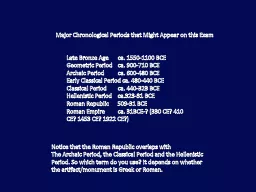

Geometric Period ca 900710 BCE Archaic Period ca 600480 BCE Early Classical Period ca 480440 BCE Classical Period ca 440323 BCE Hellenistic Period ca32331 BCE Roman Republic 50931 BCE ID: 661387
Download Presentation The PPT/PDF document "Late Bronze Age ca. 1550-1100 BCE" is the property of its rightful owner. Permission is granted to download and print the materials on this web site for personal, non-commercial use only, and to display it on your personal computer provided you do not modify the materials and that you retain all copyright notices contained in the materials. By downloading content from our website, you accept the terms of this agreement.
Slide1
Late Bronze Age ca. 1550-1100 BCEGeometric Period ca. 900-710 BCEArchaic Period ca. 600-480 BCEEarly Classical Period ca. 480-440 BCEClassical Period ca. 440-323 BCEHellenistic Period ca.323-31 BCERoman Republic 509-31 BCERoman Empire ca. 31BCE-? (330 CE? 410 CE? 1453 CE? 1922 CE?)
Major Chronological Periods that Might Appear on this Exam
Notice that the Roman Republic overlaps with
The Archaic Period, the Classical Period and the Hellenistic
Period. So which term do you use? It depends on whether
the artifact/monument is Greek or Roman.Slide2Slide3Slide4
Plan of DelphiSlide5
“Kleobis and Biton”, ca. 600-580 BCEInscription found nearby says that the artist was [Poly]medes of Argos (lit. “the Argive)Slide6
Herodotos tells the story of Kleobis and Biton....
There was a festival of Hera in Argos, and their mother absolutely had to be conveyed to the temple by a team of oxen. But their oxen had not come back from the fields in time, so the youths took the yoke upon their own shoulders under constraint of time. They drew the wagon, with their mother riding atop it, traveling five miles until they arrived at the temple. [1.31.3] When they had done this and had been seen by the entire gathering, their lives came to an excellent end, and in their case the god made clear that for human beings it is a better thing to die than to live. The Argive men stood around the youths and congratulated them on their strength; the Argive women congratulated their mother for having borne such children. [1.31.4] She was overjoyed at the feat and at the praise, so she stood before the image and prayed that the goddess might grant the best thing for man to her children
Cleobis
and
Biton
, who had given great honor to the goddess. [1.31.5] After this prayer they sacrificed and feasted. The youths then lay down in the temple and went to sleep and never rose again; death held them there. The
Argives
made and dedicated at Delphi statues of them as being the best of men. (
Herodotos
,
Histories
)Slide7Slide8
Kouroi (singular Kouros)Slide9
The Delphi Charioteer. 470s BCE, dedicated by Polyzalos, tyrant of the city of Gela (Sicily)Slide10Slide11
*P]*O*L*U*Z*A*L*O*S *M*A N*E*Q*H*K[*E*N] …*A*P*O*L*L[*O*N], "... Polyzalos dedicated me. …Apollo." The first line has been recut; the earlier, erased inscription can still be read with fair certainty: ... *G]*E*L*A*S *A*N*E[*Q]*E*K*E[*N] *A[*N]*A*S*S[*O*N], "... lord of Gela dedicated...."Slide12Slide13Slide14
Themis and AigeusSlide15
SOME DELPHIC ORACLES:630 BCE Know you better than I, fair Libya abounding in fleeces? Better the stranger than he who has trod it? Oh! Clever Therans!594 BCE First sacrifice to the warriors who once had their home in this island,
Whom now the rolling plain of fair Asopia covers,
Laid in the tombs of heroes with their faces turned to the sunset
560 BCE Whenever a mule shall become sovereign king
of the Medians, then,
Lydian Delicate-Foot, flee by the stone-strewn
Hermus
, flee,
and think not to stand fast, nor shame to be chicken-hearted
.Slide16
Plan of Delphi